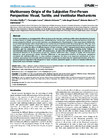Multisensory Origin of the Subjective First-Person Perspective: Visual, Tactile, and Vestibular Mechanisms
dc.contributor.author
Pfeiffer, Christian
dc.contributor.author
Lopez, Christophe
dc.contributor.author
Schmutz, Valentin
dc.contributor.author
Duenas, Julio
dc.contributor.author
Martuzzi, Roberto
dc.contributor.author
Blanke, Olaf
dc.date.accessioned
2018-10-04T09:56:59Z
dc.date.available
2017-06-10T16:39:47Z
dc.date.available
2018-10-04T09:56:59Z
dc.date.issued
2013-04-22
dc.identifier.issn
1932-6203
dc.identifier.other
10.1371/journal.pone.0061751
en_US
dc.identifier.uri
http://hdl.handle.net/20.500.11850/66493
dc.identifier.doi
10.3929/ethz-b-000066493
dc.description.abstract
In three experiments we investigated the effects of visuo-tactile and visuo-vestibular conflict about the direction of gravity on three aspects of bodily self-consciousness: self-identification, self-location, and the experienced direction of the first-person perspective. Robotic visuo-tactile stimulation was administered to 78 participants in three experiments. Additionally, we presented participants with a virtual body as seen from an elevated and downward-directed perspective while they were lying supine and were therefore receiving vestibular and postural cues about an upward-directed perspective. Under these conditions, we studied the effects of different degrees of visuo-vestibular conflict, repeated measurements during illusion induction, and the relationship to a classical measure of visuo-vestibular integration. Extending earlier findings on experimentally induced changes in bodily self-consciousness, we show that self-identification does not depend on the experienced direction of the first-person perspective, whereas self-location does. Changes in bodily self-consciousness depend on visual gravitational signals. Individual differences in the experienced direction of first-person perspective correlated with individual differences in visuo-vestibular integration. Our data reveal important contributions of visuo-vestibular gravitational cues to bodily self-consciousness. In particular we show that the experienced direction of the first-person perspective depends on the integration of visual, vestibular, and tactile signals, as well as on individual differences in idiosyncratic visuo-vestibular strategies.
en_US
dc.format
application/pdf
en_US
dc.language.iso
en
en_US
dc.publisher
PLOS
dc.rights.uri
http://creativecommons.org/licenses/by/3.0/
dc.title
Multisensory Origin of the Subjective First-Person Perspective: Visual, Tactile, and Vestibular Mechanisms
en_US
dc.type
Journal Article
dc.rights.license
Creative Commons Attribution 3.0 Unported
ethz.journal.title
PLoS ONE
ethz.journal.volume
8
en_US
ethz.journal.issue
4
en_US
ethz.journal.abbreviated
PLoS ONE
ethz.pages.start
e61751
en_US
ethz.size
15 p.
en_US
ethz.version.deposit
publishedVersion
en_US
ethz.identifier.wos
ethz.publication.place
San Francisco, CA
ethz.publication.status
published
en_US
ethz.date.deposited
2017-06-10T16:41:48Z
ethz.source
ECIT
ethz.identifier.importid
imp59365091b20e269896
ethz.ecitpid
pub:105969
ethz.eth
yes
en_US
ethz.availability
Open access
en_US
ethz.rosetta.installDate
2017-07-15T20:53:29Z
ethz.rosetta.lastUpdated
2024-02-02T06:15:13Z
ethz.rosetta.versionExported
true
ethz.COinS
ctx_ver=Z39.88-2004&rft_val_fmt=info:ofi/fmt:kev:mtx:journal&rft.atitle=Multisensory%20Origin%20of%20the%20Subjective%20First-Person%20Perspective:%20Visual,%20Tactile,%20and%20Vestibular%20Mechanisms&rft.jtitle=PLoS%20ONE&rft.date=2013-04-22&rft.volume=8&rft.issue=4&rft.spage=e61751&rft.issn=1932-6203&rft.au=Pfeiffer,%20Christian&Lopez,%20Christophe&Schmutz,%20Valentin&Duenas,%20Julio&Martuzzi,%20Roberto&rft.genre=article&rft_id=info:doi/10.1371/journal.pone.0061751&
Files in this item
Publication type
-
Journal Article [128876]

